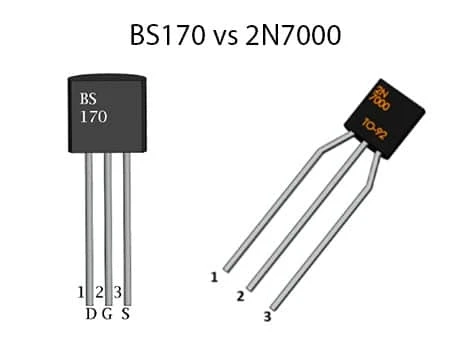The 2N7000 and BS170 are two N-channel enhancement-mode MOSFETs for low-power switching applications with different lead designs and current ratings. Other variants, such as the 2N7002, VQ1000J, and VQ1000P, are sometimes included on the same datasheet. But what is the distinction between the two? This article will answer your questions and show you how they are similar and different, as well as how they can be used interchangeably.
What is a BS170 N-Channel MOSFET?
In a TO-92 packaging, the BS170 is a well-known N-channel MOSFET. This device was made with Fairchild's unique high-density DMOS cell technology.
This ultra-high-density technology is intended to lower state resistance while providing stable, reliable, and fast switching.
It has the ability to switch as well as amplify. When used as a switch, it can drive a load of 500mA. It has quick switching capabilities and can switch loads in about 7 nanoseconds, making it suitable for use in high-speed circuits.
It can also work at low voltages, making it a good MOSFET for battery-powered applications. It can also be used as an amplifier, and it can be used in audio amplifier circuits as well as other signal amplification applications.
The BS170 is well suited for low voltage and low current applications such as tiny servo motor control, power MOSFET gate drivers, and other switching applications.
What is a 2N7000 N-Channel MOSFET?
The 2N7000 is a high-cell density N-channel enhancement mode Field-Effect Transistor made utilizing Fairchild's DMOS technology. This high-density approach was designed to reduce on-state resistance while delivering reliable, fast switching performance. It can deliver up to 2A of pulsed current and is suitable for most applications requiring up to 400mA DC.
BS170 vs 2N7000 Features Comparison
BS170 Features
• Pb-Free device
• Low offset and error voltage
• Easily driven without buffer
• High density cell design to minimize ON-state resistance RDS(ON)
• Voltage controlled small signal switch
• Particularly suits for low voltage, low current application
• High saturation current capability
• Rugged and Reliable
• Fast switching (TON = 4ns)
2N7000 Features
• Small signal N-Channel MOSFET
• Drain-Source Voltage (VDS) is 60V
• Continuous Drain Current (ID) is 200mA
• Pulsed Drain Current (ID-peak) is 500mA
• Gate threshold voltage (VGS-th) is 3V
• Gate-Source Voltage is (VGS) is ±20V
• Turn ON and Turn off time is 10ns each.
• Available in To-92 Package
BS170 vs 2N7000 Applications Comparison
BS170 Applications
• Battery operated systems
• Solid-state relays
• Drivers: Relays, Solenoids , Lamps, Hammers, Displays, Memories, Transistors, etc.
• Direct Logic-Level Interface: TTL /CMOS
2N7000 Applications
• Switching High voltage loads
• Commonly used for small signal switching
• LED dimmers or flashers
• Low power Analog converters or inverters
BS170 vs 2N7000 Where to use?
BS170
DMOS technology is used in low-voltage, low-current applications such as servo motor control, power MOSFET gate drivers, and other switching applications. The BS170 is used in most applications that require up to 500mA DC current. It is also found in high-speed circuits.
2N7000
The 2N7000 is a small-signal N-channel MOSFET. MOSFETs, which are comparable to transistors, are high-current, high-voltage power electronic switches. The 2N7000 MOSFET can switch loads with a voltage drop of less than 60 volts (VDS) and a current draw of less than 200 milliamperes (ID). This mosfet has a 3V threshold voltage and is housed in a small TO-92 package, so if you're looking for a small mosfet to switch a load, this IC might be ideal for you.
BS170 vs 2N7000 As a Circuit
BS170 As a circuit
In this setup, we're merely using a BS170 N-channel MOSFET to turn on and off an LED. The Gate and Drain terminals are connected with a 5v DC supply, and the LED is connected to the Source. When the gate pulse is given by turning on the switch, current flows from Drain to Source, and the LED begins to glow. The LED will remain on until the gate pulse is activated. When the gate pulse is no longer present, the LED turns off.
2N7000 As a circuit
As illustrated in the design of the switching model circuit using 2N7000, the gate is connected to a resistor, the load is connected to the drain, and the source is grounded.
The resistor manages the voltage and passes it to the gate for switching when we provide a signal to a MOSFET, and the load will operate as expected after MOSFET activity.
BS170 vs 2N7000 Equivalents
BS170 Equivalents
2N7000, 2N7002, VQ1000J, VQ1000P, IRLML2502.
2N7000 Equivalents
BS170, NTE 491, IRF3205, IRF540N, IRF9Z34N, IRFP250N, IRFZ44.
BS170 vs 2N7000 Package
BS170 Package
2N7000 Package
BS170 vs 2N7000 Interchangeability
Both the 2N7000 and the BS170 are TO-92 devices that operate at 60 V. The 2N7000 can switch up to 200 mA. The BS170 can switch 500 mA with a maximum on-resistance of 5 at 10 V Vgs. The 2N7002 is a similar part to the 2N7000, although it comes in a different package.
The 2N7000 and BS170 MOSFETs are the most similar devices since their voltage specs, such as terminal voltage and threshold voltage values, are identical.
However, the BS170 has a higher load capability than the 2N7000 in terms of current parameters; its power dissipation is twice that of the 2N7000.


